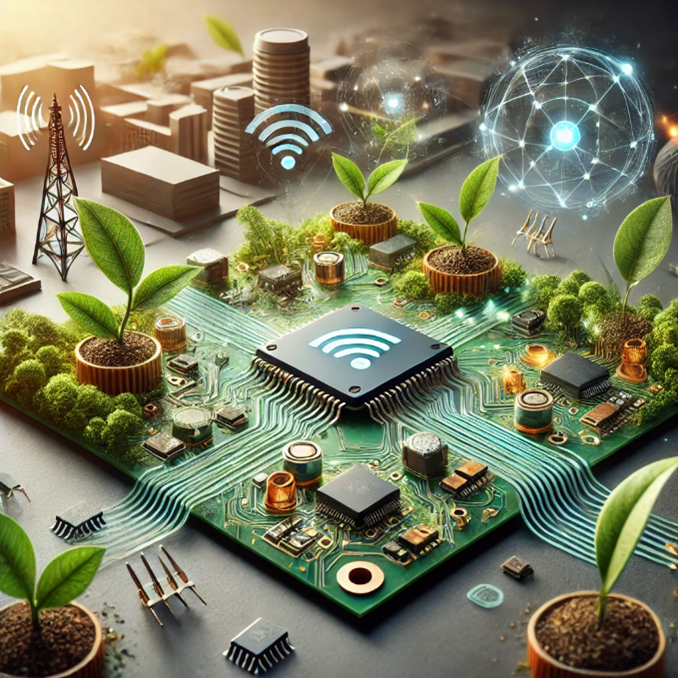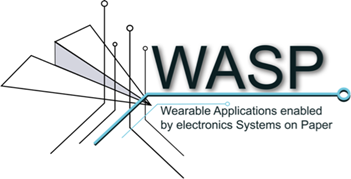


Ref: PID2020-116518GB-I00
Duration: 01/09/2021 to 31/12/2024
BIEGT aimed to promote theoretical/computational research in bio-inspired systems (BIS) based on two-dimensional materials (2DMs) as an essential step in the advanced development of bio-electronics technology.

Ref: TED2021-129938B-I00
Duration: 01/12/2022 to 31/08/2025
Resumen

Ref: TED2021-129769B-I00
Duration: 01/12/2022 to 30/11/2024
FlexPowHar explores new concepts of nonlinear electronic devices based on two-dimensional semiconductors as building blocks of high-frequency applications such as power detectors and RF-DC power converters. Rectifiers are the central component that limits the performance and operation of nonlinear radiofrequency applications. In this regard, FlexPowHar studies emerging devices based on two-dimensional materials with nonlinear current-voltage electrical characteristics, aimed at building the future wireless communication subsystems compatible with flexible electronic technology. The main objective of the FlexPowHar project is to develop physics-based computer-aided design (CAD) tools that enable and facilitate the design and optimization of new nonlinear radiofrequency circuits based on flexible two-dimensional technologies for ubiquitous Internet of Things applications.

Ref: P21_00149
Duration: 02/12/2022 to 31/12/2025
The goal of IoT is to wirelessly interconnect physical objects, enabling ubiquitous sensing and distributed computing, introducing profound changes in the connection between the physical and digital environments. This new paradigm poses the challenge of how to provide ubiquitous energy solutions to this multitude of distributed objects. Electromagnetic (EM) energy harvesting (EH) represents a novel and eco-friendly alternative to the use of batteries as it harnesses EM signals operating in the radio frequency (RF) range, such as Wi-Fi, mobile communications, and Bluetooth, which are omnipresent in modern societies and continuously growing. Simultaneously, ongoing advances in ultra-low power (ULP) circuit design have propelled ambient RF EH as an attractive alternative. This revolutionary context of low-power, ubiquitously connected electronics has received a formidable boost with the revolution surrounding graphene and related materials (GRMs). ENERGHENE seeks to harness ambient EM energy by taking advantage of graphene devices for sensing and communication ULP applications.

Ref: A-ING-253-UGR23
Duration: 29/01/2024 to 31/12/2026
To enable the widespread adoption of the Internet of Things (IoT) and accelerate its integration into industry, it is essential to achieve extremely low energy consumption in ubiquitous systems. A promising approach in this area focuses on reducing the power requirements of high-frequency (HF) systems. This can be realized by developing tunable modules that can dynamically modify their functionality to handle various tasks based on specific system needs, significantly lowering the number of required modules in an HF system. Such advancements aim to boost energy efficiency and overall performance of IoT applications.

Ref: CNS2023-143727
Duration: 01/04/2024 to 30/06/2026
RECAMBIO exploits the distinct electrical response of narrow-bandgap low-dimensional materials (LDMs) to devise novel high-frequency (HF) electronic devices and circuits able to boost the forthcoming generation of ubiquitous wireless communication systems. RECAMBIO investigates unique concepts of reconfigurable ambipolar devices as building blocks of future reconfigurable modules of IoT systems such as phase shifters, filters, power detectors and mixers.

Ref: TARGET-RF. Grant agreement ID: 101155159
Duration: 01/09/2024 to 31/08/2026
In the present day, electromagnetic (EM) signals operating within the radio frequency (RF) range, including Wi-Fi frequencies of 2.4 GHz and 5.8 GHz, and cellular telecommunication spanning from 700 MHz to 2.7 GHz, are becoming increasingly pervasive in indoor and outdoor environments. These signals constitute a prolific and continuous source of RF energy. Harnessing this RF energy holds great potential for powering future distributed electronics. However, before reaching the technology readiness level required for commercial utilization of RF harvesting, numerous factors must be taken into account. Among these considerations, the performance of diodes (rectifiers) is of paramount importance. Indeed, in most cases, the efficacy of the harvester heavily relies on the rectifier. This component ultimately enables switching-type conversions, such as alternating current to direct current (ac–dc) conversions. The most crucial parameter for assessing the rectification capabilities of a diode technology is the short-circuit current responsivity or the voltage responsivity at zero bias. In this context, graphene-based rectifiers have exhibited remarkable characteristics, including a zero-bias voltage responsivity reaching up to 71 V-1. The TARGET RF project will continue to innovate in emerging materials and device architecture. Specifically, it will concentrate on investigating the responsivity of emerging two-dimensional (2D) technologies for rectifiers, particularly focusing on Rectifiers based on various Two-dimensional transition metal dichalcogenides (TMDs).This pursuit aims to enhance the efficiency of converting RF to DC power, particularly in RF low-power density scenarios. TARGET RF (24 months) will be hosted at the Granada University and will l be supervised by Prof. Francisco Javier Garcia Ruiz, an internationally recognized expert in this area, take advantage, hence, the skills of his researcher's team and the infrastructure.

Ref: ENERGIZE Grant agreement ID: 101194458
Duration: 01/10/2024 to 30/09/2027
This technological breakthrough will be sustained on memristive, ferroelectric and floating gate two-terminal and three-terminal devices based on 2D materials The proposal seeks to eventually enhance the hardware for the implementation of Artificial Neural Networks (ANN) through chiplet-based multi-core in-memory computing technologies, providing also guidelines for evaluating and benchmarking key 2D devices and circuits parameters and performance metrics.

Ref: PID2023-150162OB-I00
Duration: 01/09/2024 to 31/08/2027
ADAGE aims to boost research on IoT edge nodes based on: i) two-dimensional materials (2DMs) and ii) new nanoelectronic device architectures, as an essential step in the development of a new generation of low-cost, low-power, autonomous, not discontinued, portable and flexible systems leading to a transparent and ubiquitous IoT architecture. The starting hypothesis assumes that to achieve a successful technological solution to the obstacles of next generation IoT, an innovative and holistic approach is required from the bottom, with innovation at the lower levels of system design, i.e. in materials and devices. With this in mind, the proposal aims to develop a theoretical-experimental framework capable of shedding light on the possibilities offered by these new materials and devices to design, implement and optimize the various circuits and modules involved in the realization of IoT systems.

Ref: PID2023-148323OA-I00
Duration: 01/09/2024 to 31/08/2027
COMPOSTRONICS aims at producing a substantial and pioneering contribution to the generation of knowledge, specifically in advancing on the adoption of sustainable printed circuit board manufacturing for high-frequency systems. At its core, this proposal seeks to bring to light the feasibility of fabricating biodegradable and compostable radiofrequency (RF) electronics, an area that has not been extensively explored in the realm of printed circuit board manufacturing. The anticipated impact on sustainable printed circuit board manufacturing is profound. The project aims to showcase that it is not only viable but also advantageous to integrate biodegradable and compostable materials into the production of RF electronics. This revelation has the potential to produce a paradigm shift in the electronics industry, influencing manufacturers, researchers, and, importantly, legislators to reconsider traditional materials in favor of more environmentally friendly alternatives.

Ref: MIETMAN. Grant agreement ID: 101032701
Duration: 01/03/2022 to 29/02/2024
The digital transformation has revolutionized human societies, but its high energy consumption, rooted in the von Neumann computational architecture, poses unsustainable environmental challenges. To address this, researchers are exploring neuromorphic architectures inspired by the brain. Memristors based on two-dimensional materials (2DMs) offer a promising solution due to their energy efficiency and ability to perform advanced functions in artificial intelligence systems. The MIETMAN project developed multiscale models and prototypes of 2DM-based memristors for neuromorphic applications, collaborating between the University of Granada (computational studies) and AMO GmbH in Germany (device fabrication and characterization). The work included atomic-level analyses of 2DMs, focusing on point defects and metal atoms causing memristance, and the development of compact models to describe their experimental behavior. These findings advance 2DM-based systems toward energy-efficient computing, with knowledge shared across scientific and non-scientific audiences.

Ref: WASP. Grant agreement ID: 825213
Duration: 01/05/2020 to 31/12/2021
The EU-funded WASP project developed a groundbreaking technology to sense biometric parameters, like glucose levels, and communicate with external readers. It introduced a new, eco-friendly printing method to create electronic devices and circuits on paper—a low-cost, biodegradable, flexible, and foldable material compatible with high-speed roll-to-roll manufacturing processes. The project aimed to revolutionize flexible and wearable electronics by enabling the integration of intelligent functions into everyday items like bandages, diapers, or patches. This innovation combines environmental sustainability with the ability to monitor biomedical parameters. A key achievement was the release of a demonstrator capable of sensing parameters such as humidity, pH, and glucose, showcasing the potential for large-scale industrial applications.
Ref: PPJIA2021-33
Duration: 01/01/2022 to 31/12/2022
Ref: EQC2018-004963-P
Duration: 01/01/2018 to 31/03/2021
Ref: TEC2017-89955-P
Duration: 01/01/2018 to 30/09/2021
Ref: EQC2019-005920-P
Duration: 01/01/2019 to 30/06/2022
Ref: CAS21/00483
Duration: 01/09/2022 to 31/12/2022
Ref: A-TIC-646-UGR20
Duration: 01/07/2021 to 30/06/2023
Ref: P20_00633
Duration: 04/10/2021 to 30/06/2023